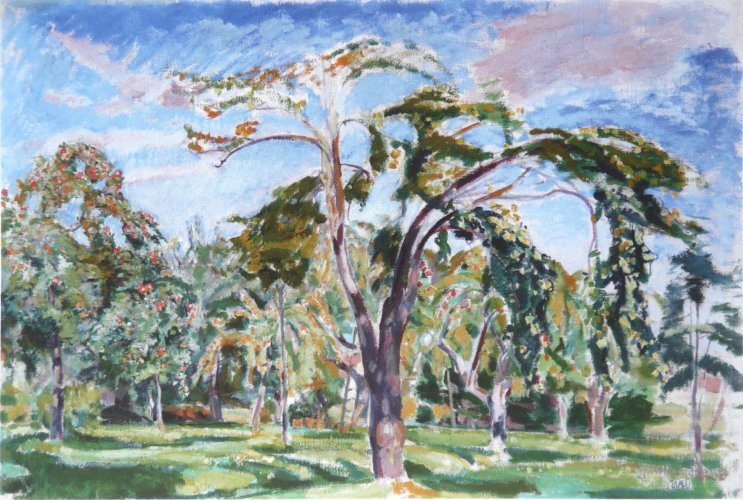Description:
Wojciech Weiss (1875-1950) studied in Krakow, but one of the most important elements of his education was his stay in Paris. He worked for the journal “Życie”, edited by S. Przybyszewski. Weiss’s art at this time was very pessimistic and symbolic-expressionist. When he got married in 1908, he and his wife settled in the Krakow suburb of Kalwaria Zebrzydowska, in a house with an old orchard around it. This place became a frequent subject of his works, which belong to the most cheerful period in the life and work of the painter.
Description of the painting:
The painting depicts a fragment of a fall orchard located near the artist’s house in Kalwaria Zebrzydowska. It is painted in bright, harmonious shades of green, blue and pinks. The orchard is bathed in bright sunlight, which interweaves with shadows, creating a decorative, almost musical composition of bright and dark colors. Weiss creates a joyful atmosphere of carefree and peace in the painting.
For a better understanding of Wojciech Weiss’s painting, it is necessary to know his private life, influences and contacts with other painters. His art is described as symbolizing expressionism, but Weiss went through many stages of artistic development. He was greatly influenced by his teachers at the Krakow School of Fine Arts, the works admired in galleries, his travels throughout Europe, his stays in France and Italy, and especially by Krakow’s “Demon”, Stanisław Przybyszewski, who invited him to collaborate in the weekly “Życie”.
Although Weiss was a sensitive artist to influences, his extraordinary talent and sensitivity to the surrounding world allowed him to develop an individual touch to his work. Throughout his life he returned to painting portraits and landscapes, images of his closest surroundings, even if it might seem banal. He created many such works while living with his parents, as a student, near Płaszów, not far from Krakow, where his father was a railway official. His landscapes, images of the surrounding station, railway tracks, wagons, painted by a barely twenty-four-year-old student, are incredibly mature. Weiss used synthesis in them, and the paintings are almost abstract, but they never completely depart from reality marked by a few perfect strokes of the brush.
The later Pan-erotic, cosmic and satanist philosophical theories of Stanisław Przybyszewski and his knowledge of the Pigalle district bohemia left an expressionist and fatalistic mark on his art. However, after receiving a scholarship, instead of going to Paris again, he decided to choose Italy. There he was fascinated by the pre-Christian ancient culture, and his painting brightened, softened and gained a statuesque gravity.
The painting “Apple Trees (Orchard)” was created in probably the happiest moment of Weiss’s life, when he married his student Irena Silberberg. Together with her, he moved to his parents’ house in Krakow’s Kalwaria Zebrzydowska. When his father retired, he bought a house beautifully located in an old orchard. It was a time when many images of parents, a wife reading, sleeping, sewing, trying on a hat in front of a mirror, and an orchard, whose trees he almost painted like family members, were created.
This period in Weiss’s art is called “white” due to the brightening of the palette and the optimistic vision of the world presented by the works of this period. It is also a time of search for light-colouristic, balancing between reality and dream, between a real world and its synthesis.
The orchard is shown in its early-autumn outfit with trees bent under the fruits. The day is sunny, the sky only covered by a pinkish cloud. The artist used simple colour combinations, creating a harmonious, peaceful image. He left the white of the canvas as a full-fledged participant, and the paints were applied very thinly. The linear rhythm of the branches gives the impression of decoration and melody at the same time.
„Apple Trees (Orchard)” is one of the first paintings depicting the surroundings of the house, of which many were created later. Kalwaria became his refuge until the end of his life, an Arcadia where he could rest from work and the crowded Krakow.


